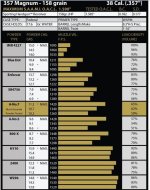I don't get it...
I don't understand the 12.3 grains of 2400 as a top load. That to me is a medium load in a .357.


PS: My Lyman book says 14.9 gr 2400 is the max.
This exactly!!!!!! You are pushing the 2400 to at or beyond max loads there.
Alliant shows a max load of 14.8 grains using a Speer 158 grain GDHP. But, if you look on the Nosler website in their load data, they show a max load of 12.3 grains of 2400 with their 158 grain JHP bullet. I am seeing some serious pressure looking at the way the primer extruded out around the circumference of the primer pocket.
BTW, how did these extract from the cylinder? Were they tight or did they come out easily?
I don't understand the 12.3 grains of 2400 as a top load. That to me is a medium load in a .357.
PS: My Lyman book says 14.9 gr 2400 is the max.
Last edited:


